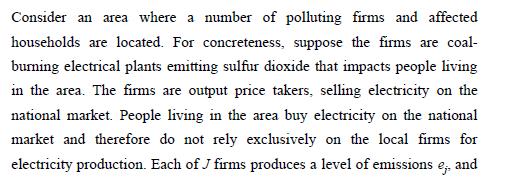Consider the basic model shown in section 3.1 , but assume the social damage function is linear
Question:
Consider the basic model shown in section 3.1 , but assume the social damage function is linear such that D(E)=d×E for d>0.
(a) Show that for an efficient amount of pollution, both individual firm and total emissions decrease with an increase in d.
(b) Derive the comparative static relationships between d and the following potential policy variables: emission tax rate, total amount of issued permits, subsidy rate.
Suppose now we have a convex damage function D(E,d) where DE(•)>0, DEE(•)>0, Dd(•)>0, and DEd(•)>0. That is, both total damage and marginal damage increase as d increases.
(c) Derive the relationship between d and the variables listed in part (b).
Data from section 3.1


Step by Step Answer:

A Course In Environmental Economics
ISBN: 9781316866818
1st Edition
Authors: Daniel J Phaneuf, Till Requate





